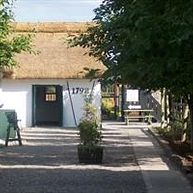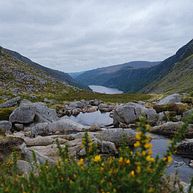
-
![Donaghmore Famine Workhouse Museum]() Provided by: Fáilte Ireland
Provided by: Fáilte Ireland

Our travel guides are free to read and explore online. If you want to get your own copy, the full travel guide for this destination is available to you offline* to bring along anywhere or print for your trip.
*this will be downloaded as a PDF.Price
€4,95
Donaghmore Famine Workhouse Museum
The guide was updated:Donaghmore Famine Workhouse Museum is a unique attraction that tells the story of the families who lived and died within the famine workhouse walls before, during and after the Great Famine of 1845-1849. The museum uses guided and self-guided tours combined with various exhibits to explain the socio-economic conditions which led to the establishment of this and other workhouses. Visitors to the museum can view an agricultural collection made up of a wide range of artefacts donated by local people, ranging from farm implements, household items and hand tools.
Useful Information
- Address: Donaghmore, Rathdowney, County Laois
- Opening hours: Mon–Fri 11am–5pm
- Website: www.discoverireland.ie/laois/donaghmore-famine-workhouse-museum
- Phone: +353 86 829 6685
Digital Travel Guide Download
Our travel guides are free to read and explore online. If you want to get your own copy, the full travel guide for this destination is available to you offline* to bring along anywhere or print for your trip.
*this will be downloaded as a PDF.Price
€4,95

The only Stud farm in Ireland open to the Public offering daily guided tours. Situated on the grounds is the world famous Japanese Gardens, which tells the story of the ‘Life of Man from the Cradle to the Grave’. In more recent times the Horse Museum was added and later for the Millennium St Fiachra’s Garden was created. Gift shop & Restaurant.
Read more

Castletown House & Parklands
Set amongst beautiful 18th century parklands, Castletown is the largest and most significant Palladian style country house in Ireland. The house was built c.1722 for the Speaker of the Irish House of Commons, William Connolly (1622- 1729). The designs of a number of important architects were used, Alessandro Gailiei, Sir Edward Lovett Pearce and Sir William Chambers. The estate was sold in 1965 and was transferred to State Care in 1994.
Read more

Lullymore Heritage & Discovery Park
The multi-award winning Lullymore Heritage & Discovery Park is set on 60 acres of breathtaking landscape close to Rathangan in County Kildare. The Park explores Irish heritage, culture and environment with woodland/peatland trails, gardens and exhibitions. It’s also a great place for the little ones with a state of the art indoor forest themed play centre, outdoor play area with crazy golf, pet farm and train trips. Fun, nature, heritage and leisure — Lullymore Heritage and Discovery Park has aunique mix of activities just waiting to be discovered!
Read more

Donaghmore Famine Workhouse Museum
Donaghmore Famine Workhouse Museum is a unique attraction that tells the story of the families who lived and died within the famine workhouse walls before, during and after the Great Famine of 1845-1849. The museum uses guided and self-guided tours combined with various exhibits to explain the socio-economic conditions which led to the establishment of this and other workhouses. Visitors to the museum can view an agricultural collection made up of a wide range of artefacts donated by local people, ranging from farm implements, household items and hand tools.
Read more

Heywood Gardens
Completed in 1912, the gardens are composed of four elements consisting of gardens, lakes, woodland and architectural features. Linked by a terrace that ran along the front of the house, which now no longer exists. The formal gardens form the centrepiece of the property and were designed by the famous architect, Sir Edwin Lutyens (1869-1944) and probably landscaped by Gertrude Jekyll (1843-1932). In the sunken garden, circular terraces descend to an elliptical pool, where small statues of turtles gaze inquisitively at the grand fountain. An extensive replanting programme is currently underway.
Read more

Rock of Dunamase
The Rock of Dunamase is an imposing and magnificent example of the remains of a Celtic fortification overlooking the valley of the O’Moores. It has a colourful history boasting ownership by Strongbow in 1170 and becoming the Norman’s most important fortification. In the fourteenth century it was burned at least twice by the Irish and later ownership went to the Earl of Thomand. It eventually fell into decay in 1795 leaving the spectacular remains. Standing at over 45 metres in height, the ruin dominates the landscape.
Read more

Highlanes Gallery
The Highlanes Gallery opened its doors in 2006 and was the culmination of many years planning to deliver a dedicated visual art space for the Irish north east region of an international standard. The gallery is sited in the former Drogheda Franciscan Church and part of the Friary, known locally as the “Highlane Church”. The main exhibition spaces are open plan and include the old church level and a new floor at the height of the old balcony and as such the character of the building is not lost.
Read more

Carlingford Heritage Centre
The Heritage Centre has on permanent display the documented history of the town with the first references to the Vikings in the area circa 850 AD, through the Norman & Medieval eras and into modern times. This historical exhibit is embellished with maps, drawings, illustrations, a beautiful wall mural, photographs and a video presentation for all to enjoy.
Read more

Monasterboice Round Tower & High Crosses
Monasterboice is most famous for its spectacular high crosses, especially the Cross of Muireadach, an outstanding example of high crosses of the early Christian period in Ireland. It is a monolith, 5 metres high, which features many detailed scenes from the Bible. The crosses stand in the shadow of a magnificent Round Tower, about 30 metres high, now missing its upper part and conical cap.
Read more

Brú na Bóinne Visitor Centre (Newgrange & Knowth)
Brú na Bóinne Visitor Centre interprets the Neolithic monuments of Newgrange, Knowth and Dowth. The extensive exhibition includes a full scale replica of the chamber at Newgrange as well as a full model of one of the smaller tombs at Knowth.
All admission to Newgrange and Knowth is through the Visitor Centre, there is no direct access to these monuments. Visitors are brought from the Visitor Centre to the monuments by shuttle bus.
Read more

Hill of Tara
Though best known as the seat of the High Kings of Ireland, the Hill of Tara has been an important site since the late Stone Age, when a passage-tomb was constructed there. Tara was at the height of its power as a political and religious centre in the early centuries after Christ. Attractions include an audio-visual show and guided tours of the site.
Read more

Battle of the Boyne Visitor Centre
The Battle of the Boyne between King William III and his father-in-law, King James II, was fought in 1690. Both kings commanded their armies in person at stake were the British throne, French dominance in Europe and religious power in Ireland. The Battle of the Boyne Visitor Centre is located in the recently restored 18th century Oldbridge House, which is on the battle site.
Read more

Glendalough Monastic Site & Visitor Centre
This early Christian ecclesiastical settlement was founded by St Kevin in the 6th century. Set in a glaciated valley with two lakes, the monastic remains include a superb round tower, stone churches and decorated crosses. The Visitor Centre has an interesting exhibition, also French, Italian and Spanish guided tours are available all year by advance booking.
The Glendalough Cathedral, also known at St Peter and St Pauls' Cathedral, is a major attraction in the county. Find it next to the famed Round Tower and Our Lady's Church.
Read more

Powerscourt Estate, House & Gardens
Come explore Ireland’s most beautiful and intriguing estate. Set in the wild Wicklow countryside, overlooking the Sugarloaf Mountain, Powerscourt Gardens stretch over 47 acres and offer magnificent views of the surrounding countryside. From the ornate Italian Gardens, to the formal walks of the Rose and Kitchen Gardens, there is much to see and explore. Located just 20 kilometres south of Dublin City Centre, Powerscourt is within easy reach.
Read more

Wicklow Mountains National Park
The National Park, which covers much of upland Wicklow, contains an area of approximately 20,000 hectares (49,421 acres). This includes large areas of mountain blanket bogs, including the Lugnaquilla, Liffey Head Bog complexes and Glendalough Wood Nature Reserve. The National Park provides protection for the landscape and wildlife, from rare orchids to the wild and beautiful Peregrine Falcon. The information Point and Education Centre for the park are located in the Upper Lake of the Glendalough Valley. The Education Centre provides a range of courses and tours for schoolchildren, students and other groups.
Read more


